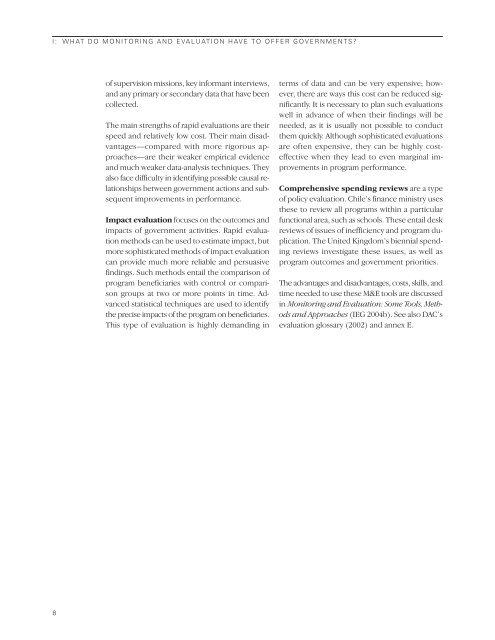How to Build M&E Systems to Support Better Government How to ...
How to Build M&E Systems to Support Better Government How to ...
How to Build M&E Systems to Support Better Government How to ...
You also want an ePaper? Increase the reach of your titles
YUMPU automatically turns print PDFs into web optimized ePapers that Google loves.
I: WHAT DO MONITORING AND EVALUATION HAVE TO OFFER GOVERNMENTS<br />
of supervision missions, key informant interviews,<br />
and any primary or secondary data that have been<br />
collected.<br />
The main strengths of rapid evaluations are their<br />
speed and relatively low cost. Their main disadvantages—compared<br />
with more rigorous approaches—are<br />
their weaker empirical evidence<br />
and much weaker data-analysis techniques. They<br />
also face difficulty in identifying possible causal relationships<br />
between government actions and subsequent<br />
improvements in performance.<br />
Impact evaluation focuses on the outcomes and<br />
impacts of government activities. Rapid evaluation<br />
methods can be used <strong>to</strong> estimate impact, but<br />
more sophisticated methods of impact evaluation<br />
can provide much more reliable and persuasive<br />
findings. Such methods entail the comparison of<br />
program beneficiaries with control or comparison<br />
groups at two or more points in time. Advanced<br />
statistical techniques are used <strong>to</strong> identify<br />
the precise impacts of the program on beneficiaries.<br />
This type of evaluation is highly demanding in<br />
terms of data and can be very expensive; however,<br />
there are ways this cost can be reduced significantly.<br />
It is necessary <strong>to</strong> plan such evaluations<br />
well in advance of when their findings will be<br />
needed, as it is usually not possible <strong>to</strong> conduct<br />
them quickly. Although sophisticated evaluations<br />
are often expensive, they can be highly costeffective<br />
when they lead <strong>to</strong> even marginal improvements<br />
in program performance.<br />
Comprehensive spending reviews are a type<br />
of policy evaluation. Chile’s finance ministry uses<br />
these <strong>to</strong> review all programs within a particular<br />
functional area, such as schools. These entail desk<br />
reviews of issues of inefficiency and program duplication.<br />
The United Kingdom’s biennial spending<br />
reviews investigate these issues, as well as<br />
program outcomes and government priorities.<br />
The advantages and disadvantages, costs, skills, and<br />
time needed <strong>to</strong> use these M&E <strong>to</strong>ols are discussed<br />
in Moni<strong>to</strong>ring and Evaluation: Some Tools, Methods<br />
and Approaches (IEG 2004b). See also DAC’s<br />
evaluation glossary (2002) and annex E.<br />
8
















![[PDF] Community Development Toolkit - CommDev](https://img.yumpu.com/48616495/1/184x260/pdf-community-development-toolkit-commdev.jpg?quality=85)
